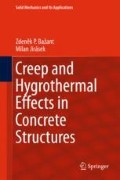Abstract
Introduction of computers several decades ago was a quantum jump in what is feasible in creep structural analysis. It made possible efficient step-by-step evaluation of history integrals or integration of differential equations for both frame-type and finite element creep analysis of structures. Closer to the first principles is the numerical analysis based on history integrals. We discuss it first and point out its limitations due to excessive computer demands. Then, we present the rate-type conversion of creep analysis with aging, which represents a generalization of the Kelvin chain model of classical viscoelasticity, leads to far more efficient calculations, and makes it easy to take into account the effects of drying, variable environment, and cracking. We examine the accuracy and numerical stability of various numerical integration schemes and emphasize the exponential algorithm, which is unconditionally stable, allowing arbitrarily increasing time steps as the stress changes fade out. The algorithm is first presented for a nonaging Kelvin chain and then extended to a solidifying chain and to a chain with general aging.
Notes
- 1.
The superscript “minus” at the lower bound \(t_1^-\) of the integral in (5.1) emphasizes that integration in the Stieltjes sense starts just before time \(t_1\), so that the potential initial change of stress by a jump is captured correctly. In fact, if the stress history contains jumps, numerical accuracy is increased by treating the corresponding terms separately, in the spirit of formula (2.15). This is equivalent to using zero-duration time steps associated with the stress jumps at certain discrete times. More specifically, if the stress has a jump at time \(t_\mathrm{jump}\), we select the time steps of the numerical scheme such that \(t_k=t_\mathrm{jump}^-\) and \(t_{k+1}=t_\mathrm{jump}^+\) for a certain time step number k. The duration of that step, \(\varDelta t_k\), is then zero, but the stress increment, \(\varDelta \sigma _k=\sigma (t_\mathrm{jump}^+)-\sigma (t_\mathrm{jump}^-)\), is nonzero and corresponds to the stress jump.
- 2.
Since the exact value of the strain at time 90 days is not available (for the log-double-power law, the integral expression for strain cannot be evaluated analytically), it is not possible to evaluate the true error. Instead of the difference between the numerical solution and the exact one, the error is considered here as the difference between the numerical solution for the given step size and a more accurate numerical solution obtained with the step size divided by two. Such a pseudo-error exhibits the same asymptotic behavior as the actual error and thus can serve for examination of the convergence rate.
- 3.
Note that \(R_1=0\) represents the value \(R(t_1^-, t_1)\) just before the application of strain, and \(R_2=\bar{E}_1\) represents the value \(R(t_1^+, t_1)\) just after the application of strain, i.e., the asymptotic modulus.
- 4.
In fact, \(\alpha =0\) means that the strain rate is evaluated at the beginning of the step and then assumed to be constant, which corresponds to the forward Euler method. Similarly, \(\alpha =1\) means that the strain rate (considered as constant during the step) is evaluated at the end of the step, which corresponds to the backward Euler method. The standard trapezoidal rule, which deals with the average of the initial and final rates, is obtained for \(\alpha =0.5\).
- 5.
The numerical approximation of the integral in (5.28) based on the STR is exact for a linear function, and so the error of integration from \(t_k\) to \(t_k+\varDelta t\) is dominated by the quadratic part of the integrand and is proportional to \((\varDelta t)^3\). The total number of time steps over an interval of fixed length is inversely proportional to \(\varDelta t\), and so the cumulative error is proportional to \((\varDelta t)^2\). For all other versions of the GTR, with \(\alpha \ne 0.5\), the integration is exact for a constant function only, and the error is due to the linear part of the integrand, thus being proportional to \((\varDelta t)^2\) in one time step and to \(\varDelta t\) after accumulation over a fixed interval.
- 6.
Continuity of strain follows from boundedness of the strain rate, which in turn follows from the boundedness of the viscous stress (equal to the product of a finite viscosity and the strain rate). Note that we work here on the level of one Kelvin unit, which will later become a part of a Kelvin chain. The chain usually contains a spring that reflects the instantaneous elastic response. So the total strain of the chain can change by a jump, but such a jump is fully accommodated by the elastic spring, and the partial strains in Kelvin units remain continuous.
- 7.
Author information
Authors and Affiliations
Corresponding author
Rights and permissions
Copyright information
© 2018 Springer Science+Business Media B.V.
About this chapter
Cite this chapter
Bažant, Z.P., Jirásek, M. (2018). Numerical Analysis of Creep Problems. In: Creep and Hygrothermal Effects in Concrete Structures. Solid Mechanics and Its Applications, vol 225. Springer, Dordrecht. https://doi.org/10.1007/978-94-024-1138-6_5
Download citation
DOI: https://doi.org/10.1007/978-94-024-1138-6_5
Published:
Publisher Name: Springer, Dordrecht
Print ISBN: 978-94-024-1136-2
Online ISBN: 978-94-024-1138-6
eBook Packages: EngineeringEngineering (R0)

